The A.J.S. Type 'F'
Receiver - Inside Out

|
Background
The A.J.S. type ‘F’ receiver used the company’s standard T.R.F.
design that was used in most of the A.J.S. non-superhet
receivers. The same components are used in many of the cheaper
two and three valve sloping panel models, the more expensive
table models, the pedestal receivers and the top of the range
Console receiver.
|
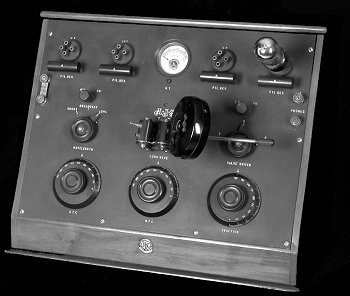
The sloping panel type 'F' receiver with one
of the long wave coils removed. Courtesy of Marco Manfredini. |
Components
Most of the components were made by the company.
Charles Hayward who was in charge of the sidecar section at
Lower Walsall Street works was asked to design a coil-winding
machine so that A.J.S. could produce its own coils. Not only
R.F. coils were produced but also the audio coupling coils that
were a feature of many of the receivers. The company made
everything except for the valves, control knobs and the meter.
It is uncertain as to whether the laminations for the audio
chokes were made in-house.
|
|

The receiver's back panel. Courtesy of Marco
Manfredini. |
|

Part of an advert from 1926
|
The valves used in A.J.S. receivers were initially
made by Mullard and carried the company’s logo. When A.J.S. started
receiver production in 1923, valves used plain tungsten filaments
which had to be heated to around 2,000 degrees centigrade to obtain
adequate emission. These were understandably called ‘Bright
Emitters’ and required high filament currents and had a relatively
short life. They were very expensive and it was common for suppliers
to offer a service to replace a burnt-out filament. Around 1925 this
all changed with the development of ‘Dull Emitters’. These use a
filament that is coated with Barium or Strontium oxide and gives a
much higher electron emission level than plain tungsten. The
filaments now only have to be heated to around 800 degrees and only
emit a dull glow, hence the name. The filament current is greatly
reduced and the valves last a lot longer. Mullard’s dull emitters
are the PM series and these were used in the A.J.S. models for 1925.
From 1926 onwards the company decided to use ‘Six-Sixty’ valves,
which were made by The Electron Company in London. |
Six-Sixty valves were available with different
filament voltages. The types used by A.J.S. with a 2 volt
accumulator were:
|
H.F. amplifier or
detector – S.S.2HF
Detector or L.F.
(non-microphonic) – S.S.2a
Audio output – S.S.10
|
|
| A.J.S. accumulators were made by Joseph Lucas Ltd.,
and the high tension batteries were made by Ever Ready, Columbia and
Siemens. |
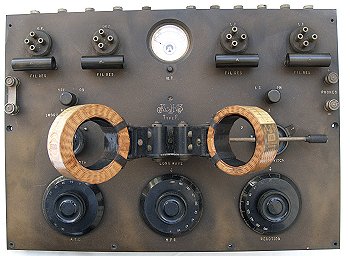 |
A receiver front panel showing the
A.J.S. made valve holders. |
| A.J.S. always produced it’s own loudspeakers.
Initially these were horn loudspeakers which used a telephone- type
earpiece with a metal diaphragm. They were available with a wood or
metal horn, but in either case the quality from such a device is
very poor when compared with what we are used to today. Later on
moving iron loudspeakers with paper cones were produced in the
Stewart Street works. Not many of these have survived and it’s hard
to know how they sounded. |
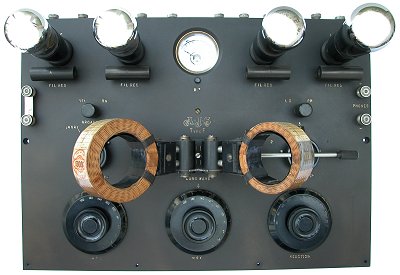
The receiver's front panel. |

The moving iron meter and meter switch.
|
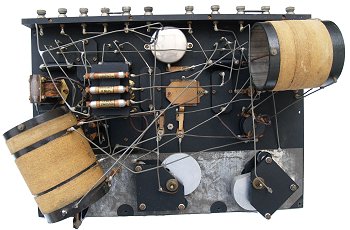
The underside of a type 'F' receiver. |
When A.J.S. radio production ended, Stewart Street
works were purchased by the Symphony Gramophone and Radio Company
and they used moving iron loudspeakers based on the A.J.S. design.
Their loudspeakers were very good indeed and compared favourably
with modern types, so it’s likely that the sound quality from the
later A.J.S. loudspeakers was equally good.
A.J.S. also sold headphones. These were of the standard type of
the day and it is doubtful if they were made in Wolverhampton. |
| The type ‘F’ receiver is a four valve T.R.F. design
consisting of a tuned high frequency amplifier, a detector and two
audio amplifiers. It covers three wavebands; short wave (higher end
of the medium wave band), broadcast (lower end of the medium wave
band) and long wave. A vario-coupled reaction circuit is used which
prevents external radiation on the short wave and broadcast bands
and a metal screen is incorporated to eliminate the possibility of
hand capacitance effects. Provision is made for switching-out the
last two valves, so that the receiver can operate as a two, three or
four valve radio to reduce battery consumption. In the 1920s high
tension batteries were very expensive and the accumulators usually
had to be taken to a local shop for charging, so this kind of
facility would appeal to purchasers. Each valve is fitted with a
plug-in resistor in series with the filament so that a wide range of
valves with different filament voltages could be used. A range of
suitable plug-in resistors was available from A.J.S. dealers. |
| The high frequency amplifier has separate aerial and
output tuned circuits and is neutralised. The coils are wound on
large diameter formers using heavy gauge copper wire. In the mid
1920s this was considered to be good practice because it offered
excellent mechanical stability and a low internal capacitance and
resistance. |
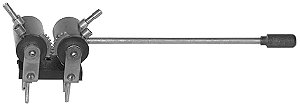
The plug-in long wave coil holder and coil
arm. Courtesy of Marco Manfredini. |
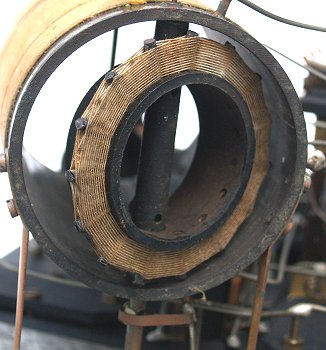 |
The basket wound reaction coil. |
|
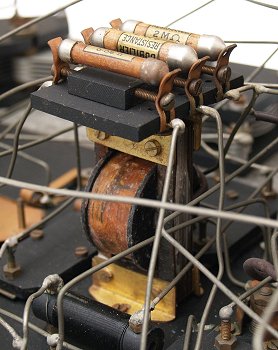
An A.J.S. patent audio coupling choke.
The leaky grid detector also provides feedback for reaction and
the audio stages are choke coupled. A.J.S. always favoured choke
coupling and claimed that it produced a higher quality sound than
conventional transformer coupling. Choke coupling was never popular
and was developed because a choke was cheaper to produce than a
transformer and the low dc resistance of the coil meant that the
valve anode was at a higher voltage than when used with an anode
load resistor so that a larger audio signal could be produced. This
was felt to be important because at the time most receivers were
battery powered and so the HT voltage was not that high. In practice
any improvement would only have been marginal.
Circuit Description
High Frequency Amplifier |
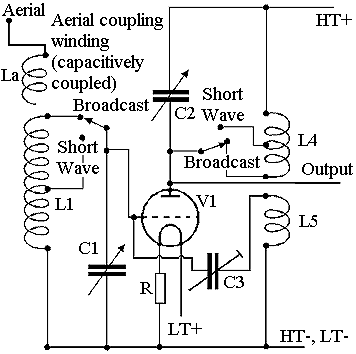
A simplified version of the high frequency
amplifier showing just the short wave and broadcast band components. |
Broadcast and Short wave bands
The aerial tuned circuit consists of L1 and C1, L1 being tapped
for short wave. La is the aerial coupling coil which acts as a
coupling capacitor (one end is not connected).
The output of the
amplifier is tuned by L4 and C2. L4 is tapped for short wave and is
mounted at right angles to L1 to prevent feedback.
The internal
capacitance of the valve could produce instability and this is
eliminated by neutralising circuit L5 and C3.
The negative feedback
from L5 is adjusted by C3 to counteract any positive feedback
resulting from the valve’s internal capacitance.
|
| Two terminals on the front panel, normally linked,
allow for the connection of an external tuning coil and two
terminals on the back panel (labelled R and R and normally linked)
in series with V1 grid, allow an A.J.S. Patent Rejector Circuit to
be used with the receiver. |
Long
wave band
External plug-in aerial and anode tuned circuits are used on
long wave. Aerial coil L2 and output coil L3 plug into a switched
socket on the front panel. When the coils are removed their
connections on the socket are automatically short-circuited.
In use
long wave is selected on the rotary wavelength switch and the coil
arm is raised. If the arm is fully lowered the coils are
switched-out. The arm controls the coupling between the coils.
They
are connected so that positive feedback will result if the coils are
closely coupled and so the arm acts as the long wave reaction
control. L4, L5 and C3 remain in circuit on long wave to provide
neutralisation and the aerial is directly connected to the aerial
tuned circuit.
|
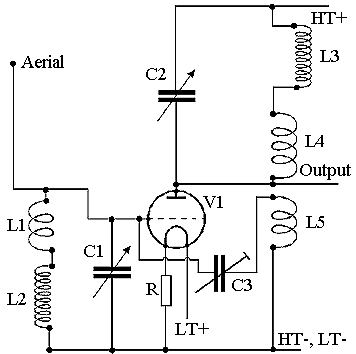
A simplified version of the high frequency
amplifier showing just the long wave components. |
| A range of plug-in coils was available allowing
the receiver to operate down to 55KHz. |
|
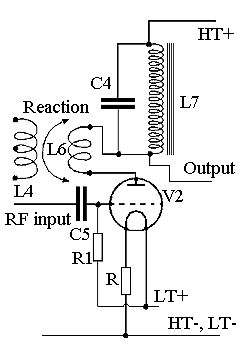
The detector.
|
Detector
The detector is a conventional leaky grid
detector, directly RC coupled from V1 anode. L6 is mounted
inside L4 and is rotated by the reaction control knob to alter
the amount of coupling between the two coils.
This provides
positive feedback for reaction. L6 is a very thin coil so that
the coupling between the coils at zero reaction can be reduced
to an extremely low value. It also provides an extremely fine
and precise reaction adjustment.
This type of coil used to be
described as ‘basket wound’ and sometimes called a basket coil.
On the short wave and broadcast bands this is the only reaction
control, but on long wave the main reaction is adjusted by the
coil arm and the reaction knob becomes a fine reaction control.
C4 filters out any remaining carrier wave and the audio signal
is developed across audio coupling choke L7.
|
|
Audio Amplifier
The first audio amplifier is RC coupled from the detector
by C6 and R1, the audio output being developed across coupling
choke L8.
The two coupling chokes L7 and L8 are mounted at right
angles to one another to minimise feedback in the audio
amplifier. The output valve is RC coupled to V3 anode by C7 and
R2 and provides a direct output for a horn loudspeaker, moving
iron loudspeaker or headphones.
The loudspeaker positive
terminal is directly connected to the HT(3) + terminal on the
back panel so that the audio output can be supplied from a
separate, or higher voltage supply.
|
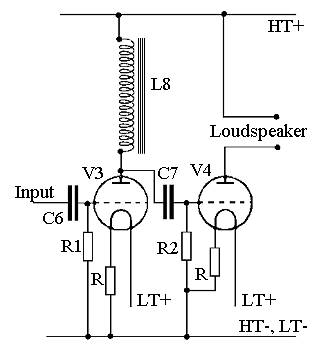
The two-stage audio amplifier.
|
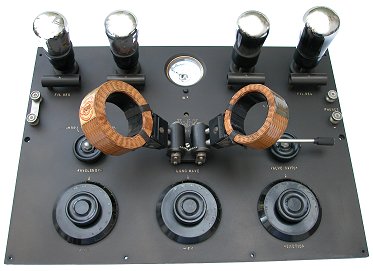
The receiver front panel.
|
We would like to thank Marco Manfredini for
providing some excellent photographs.
We would also like to add technical details of other A.J.S.
receivers and if anyone has any information please email the
webmaster.

|
 |
Return to the
A.J.S. section |
Return to the
Technical Menu |
|
|